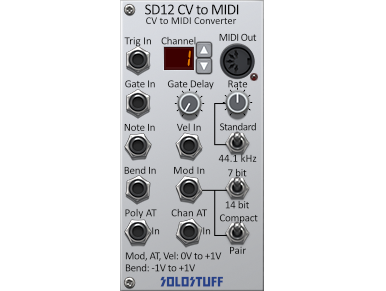Product Description
(This module is included in the System B)
The SD12 is a single voice CV to MIDI converter. The focus here is on key/note MIDI data and related MIDI messages. Most common uses and some advanced features are provided that are not usually common in similar hardware or software MIDI generators
When the module receives a high voltage in the Gate In patch point. It sends a “MIDI on” (key down) message through the MIDI Out. The message contains the MIDI note present at the Note In with the the velocity present at Vel In. Note In accepts 0.1v/oct standard voltages and Vel In accepts voltages from 0V to 1V. The Gate Delay specify how long the module waits after the gate is received and before it sends the “Note On” MIDI message. The delay ranges from a minimum of 1 sample* to a maximum of 150ms when the knob is at full. This brief waiting time can be important if you are receiving the Note In voltage from a hardware sequencer specially if it’s being sequenced by the same gate that is being sent from SoloRack. As the Note voltage from the sequencer may take some time to propagate through the hardware to your DAW into SoloRack.
Bend In takes pitch bend voltages in the range -1V to +1V and converts that to corresponding pitch bend MIDI messages. Mod In takes modulation wheel voltages in the range 0V to +1V and converts that to corresponding modulation wheel MIDI messages. Chan AT (channel aftertouch) and Poly AT (polyphonic aftertouch) both take voltages from 0V to +1V and converts them to aftertouch** MIDI messages. Notice that Poly AT will only respond while the “Note ON” (key) is being held down, hence it’s polyphonic, so each key can have it’s own after touch (when using multiple SD12 modules). While Chan AT will always respond regardless of whether or not a key is held***.
Since modulation wheel changes are CC messages. They can be either 7bit for a resolution of 128 steps or 14bit for a higher resolution of 16384 steps. This can be chosen by a switch. Notice that the MIDI receiver (software or hardware) has to support 14bit MIDI for it to work properly. If you hear stepping while modulating pitch or cut-off, it’s probably because the receiver doesn’t support or hasn’t been configured to support 14bit CC. However, if there is no stepping that doesn’t necessarily mean that the receiver supports 14bit CC, it could be that the receiver is doing some smoothing internally.
Aftertouch is always 7bit by the MIDI standard. Pitch bend is always 14bit by the MIDI standard. Both are not CC messages but specialized MIDI messages.
14bit CC (Mod wheel in this case) requires two values/messages. Course (MSB) and Fine (LSB). 7bit sends only Course. The Compact/Pair switch chooses between two methods of sending 14bit CC messages. The Compact methods sends Course values only when it changes while always sending Fine values. This is a standard method in MIDI. The Pair method always sends both Course and Fine values, which requires more bandwidth. Use Pair only for compatibility issues when your receiver doesn’t work with Compact mode.
The MIDI channel can be chosen manually by the LED digits buttons. The channel can also be increased or decreased by sending a positive or negative trigger to the Trig In (respectively). Notice that the channel number will cycle in a round robin fashion (It will go back to 1 when it increases above 16, and vise versa). This will allow you to cycle through the channels using CV by having a recurring positive (or negative) trigger.
The Rate knob determines how fast the module poles the input CVs for values and converts them to MIDI messages. The higher, the smoother the output but also the more MIDI bandwidth and CPU it will consume. The near by switch sets the range at which the Rate knob works. In Standard mode, the Rate knob minimum rate is 10 poles/second and the maximum is about 781 poles/second which equates to the MIDI standard 3125 bytes/second. In 44.1kHz mode, the minimum is 700 poles/second and the maximum is 44.1k poles/second. Notice that this last option is an extremely high setting for the MIDI standard (specially for non-USB MIDI) and should probably not be used for sending MIDI to hardware unless you know that your hardware can handle it, Of-course, you could try, but expect hanging and problems.
Each CV input gets a fair share of the set rate except for MIDI notes which are prioritized and never dropped.
Technical Details:
As it is obvious from the Rate knob description above. SoloRack can internally send and receive MIDI at a much higher rate than the MIDI standard. As a result it is advised to keep the Rate at or bellow the default setting if you intend to send MIDI outside SoloRack. Other plugins and your DAW may or may not be able to handle a very high Rate. MIDI over USB usually has a higher rate than old fashioned DIN MIDI. If you like geeking out things, you could experiment with different rates, try to find the lowest rate that sounds acceptable.
*To calculate the 1 sample delay. Devide 1 over the sampling rate. (1/sample rate). When oversampling. Devide over the oversampling rate.
**After touch is the “Pressure” applied after fully pressing a key. Hardware support is required.
***Poly after touch messages are different than Channel after touch messages. Poly after touch messages include note information indicating which note the message is tied to. Channel after touch are not bound to a note, they are meant for the whole MIDI channel.
*Voltages here are obviously quantize to fit the MIDI binary standard of 7bits giving values from 0 to 127.


Reviews
There are no reviews yet.